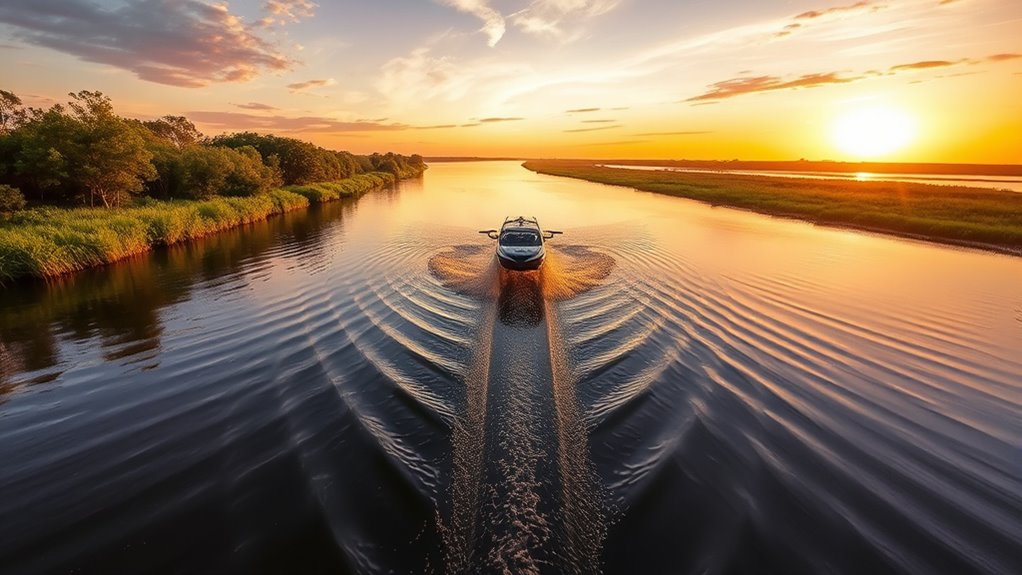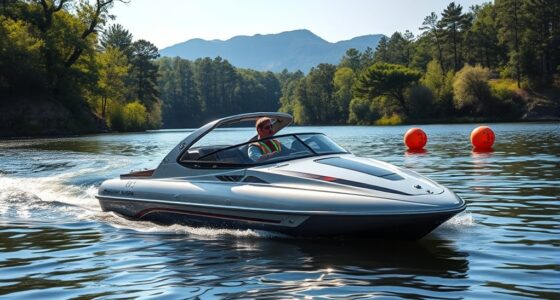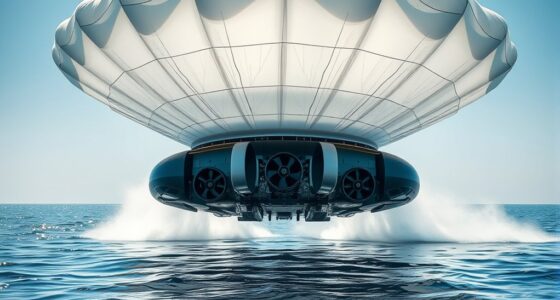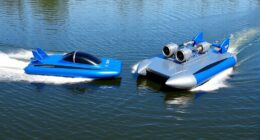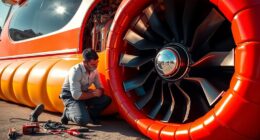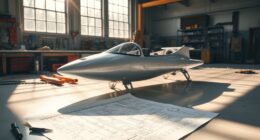When considering hovercraft use, you’ll want to focus on materials, noise pollution, and habitat impact. Choose eco-friendly materials to reduce your carbon footprint. Be aware that hovercraft engines can be noisy, disturbing wildlife and communities—select quieter models when possible. Additionally, navigate responsibly to prevent disrupting delicate ecosystems. By making informed choices, you can balance hovercraft operation with environmental stewardship—there’s more to explore on how to make your hovercraft use sustainable.
Key Takeaways
- Sustainable materials and recycled components in hovercraft construction can significantly reduce environmental impact and carbon footprint.
- Noise pollution from hovercraft can affect wildlife and communities, so selecting models with noise reduction technology is essential.
- Hovercraft can disrupt sensitive ecosystems; operators must avoid ecologically fragile areas and adhere to environmental protection regulations.
- Responsible navigation practices are crucial to prevent habitat damage and respect natural landscapes during hovercraft operations.
- Investing in eco-friendly materials and technologies may lead to long-term savings in maintenance and operational costs.
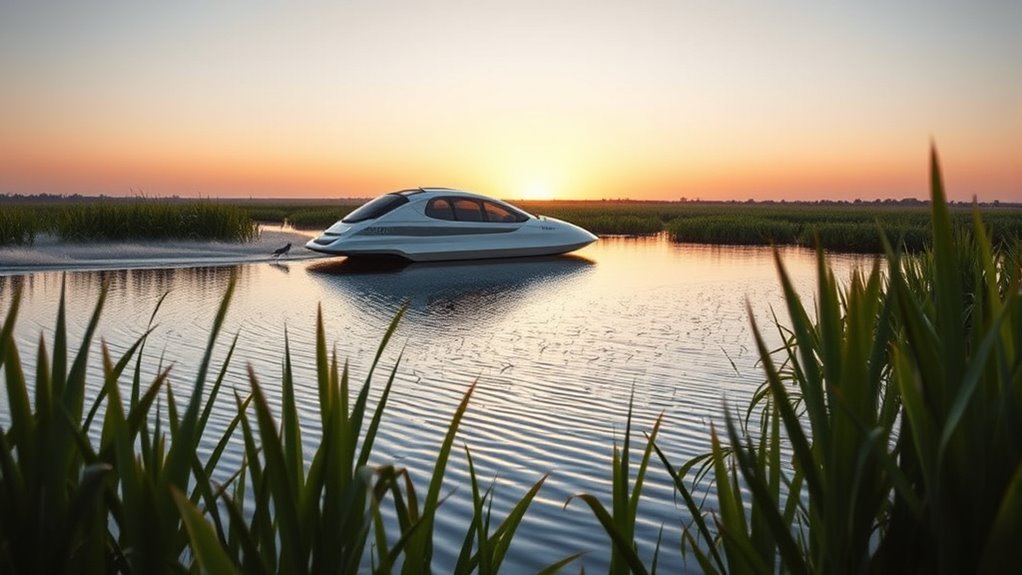
As hovercraft gain popularity for their versatility in maneuvering various terrains, it’s essential to take into account their environmental impact. While these innovative vehicles offer unique advantages, their use can raise significant concerns regarding eco-friendliness and sustainability. If you’re considering using or investing in a hovercraft, understanding these implications will help you make informed choices.
One of the most pressing issues surrounding hovercraft is the materials used in their construction. Many manufacturers still rely on traditional materials that may not prioritize sustainability. However, you can find options that utilize eco-friendly materials, which not only reduce the carbon footprint but also promote a more responsible approach to design. For instance, look for hovercraft made with biodegradable composites or recycled materials. By choosing such alternatives, you can play a part in minimizing the ecological impact associated with hovercraft production.
Noise pollution is another critical factor to consider. Hovercraft are known for their unique ability to glide over land and water, but this can come at a cost. The sound generated by their engines and fans can disturb wildlife and nearby communities. If you plan to operate a hovercraft in sensitive areas, be mindful of the noise levels it produces. Opting for models designed with noise reduction technology can greatly alleviate this concern. Manufacturers are increasingly focusing on quieter engines and better sound insulation to create a more peaceful experience for both users and the environment.
Moreover, you should consider the hovercraft’s operational impact on the habitats you traverse. While they can access remote areas, this convenience can lead to unintended consequences for local ecosystems. Be conscious of the environments you navigate, and avoid areas where hovercraft usage could disrupt wildlife or delicate plant life. Respecting natural habitats and adhering to local regulations can go a long way in ensuring that your hovercraft experience is sustainable. Additionally, it is vital to remain informed about grocery savings strategies that can help offset the costs associated with hovercraft maintenance and operation.
Frequently Asked Questions
How Do Hovercraft Engines Compare in Emissions to Traditional Boats?
Hovercraft engines generally produce lower emissions compared to traditional boats, especially if they meet modern engine emission standards. You’ll find that many hovercraft are adapting to alternative fuel options, which can further reduce their environmental impact. By choosing a hovercraft designed with cleaner technologies, you’re not just enjoying a unique mode of transport; you’re also contributing to a more sustainable future while steering waterways with reduced emissions.
Are Hovercrafts More Fuel-Efficient Than Other Watercraft?
Hovercraft can be more fuel-efficient than traditional watercraft, especially when using alternative fuels. Their unique design allows them to glide over surfaces with less resistance, which boosts energy efficiency. You’ll find that hovercraft engines often consume less fuel for the same distance compared to boats. However, actual efficiency can vary based on factors like weight, engine type, and operating conditions, so it’s always good to compare specific models when making decisions.
What Materials Are Hovercraft Constructed From to Minimize Environmental Impact?
Hovercraft are often constructed from sustainable materials like lightweight composites and aluminum, which reduce their overall environmental impact. You’ll find that many manufacturers use eco-friendly coatings to minimize harmful emissions and improve durability. By choosing these materials, hovercraft not only enhance fuel efficiency but also contribute to a greener future. When considering a hovercraft, look for models that prioritize sustainability in their design and materials for a more responsible choice.
Can Hovercraft Be Used in Sensitive Ecosystems Without Causing Harm?
Absolutely, hovercraft can glide over sensitive ecosystems without causing harm, if designed with eco-friendly principles in mind. Their unique ability to hover reduces habitat disturbance markedly compared to traditional vessels. You’ll find that when using hovercraft with careful consideration for their impact, they can navigate delicate environments almost like a whisper in the wind. By prioritizing low-emission technology and sustainable materials, you can help protect these crucial ecosystems while enjoying your adventures.
How Does Hovercraft Noise Pollution Affect Wildlife in Protected Areas?
Hovercraft noise pollution can profoundly impact wildlife in protected areas. When you operate a hovercraft, the loud sounds can cause wildlife disturbance, leading animals to flee their habitats or change their behaviors. This can disrupt their feeding, mating, and nesting activities, ultimately harming their populations. If you’re using hovercraft in these sensitive areas, it’s essential to consider how the noise might disrupt habitats and affect the delicate balance of the ecosystem.
Conclusion
In the grand tapestry of our ecosystems, hovercraft can either weave a harmonious thread or unravel the delicate balance. As you navigate the waters of innovation and efficiency, remember that every choice ripples across the environment. By prioritizing sustainable practices and minimizing disturbances, you can guarantee that hovercraft use becomes a gentle breeze rather than a storm. Embrace this responsibility, and let your actions echo with the promise of a greener future for generations to come.

